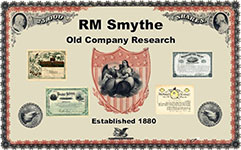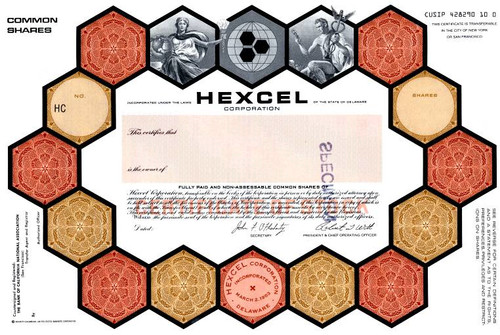Beautiful specimen certificate from the Lattice Semiconductor Corporation printed in 1994. This historic document was printed by the Security - Columbian Company and has an ornate border around it with a vignette of the company name and logo. This item has the printed signatures of the Company's President, and Secretary. 
Certificate Vignette Founded 1983, public since 1989 Headquarters Hillsboro, Oregon, Key people Bruno Guilmart, CEO Industry Integrated Circuits Products FPGAs, CPLDs Revenue $222.3 million (2008) Employees 770 (2009) Website www.latticesemi.com Lattice Semiconductor Corporation (NASDAQ: LSCC) is a United States based manufacturer of high-performance programmable logic devices (FPGAs, CPLDs, & SPLDs). Founded in 1983, the company employs about 770 people and has annual revenues of $222.3 million, with Bruno Guilmart as the chief executive officer. The Oregon based company is the number four ranked company in world market share for field-programmable gate array (FPGA) devices, and number two for CPLDs & SPLDs. The company went public in 1989 and is traded on the NASDAQ stock exchange. Lattice was founded on April 3, 1983, by C. Norman Winningstad, Rahul Sud, and Ray Capece. Winningstad, Harry Merlo, Tom Moyer, and John Piacentini were the early investors in the company. Co-founder Sud left as president in December 1986, and Winningstad left in 1991 as chairman of the board. Lattice was incorporated in Oregon in 1983 and reincorporated in Delaware in 1985. Early struggles led to chapter 11 bankruptcy reorganization in July 1987. The company emerged from bankruptcy after 62 days and moved into a smaller headquarters in Hillsboro, Oregon, from what was then an unincorporated area near Beaverton. The next year the company posted then record revenues while shrinking from 140 employees to 75 employees after the bankruptcy. Cyrus Tsui became the company's chief executive officer in 1988. On November 9, 1989, Lattice became a publicly traded company when its shares were listed on the NASDAQ after in initial public offering. The initial share price was $6, and raised almost $14 million in capital for the company. In July 1990, Lattice raised an additional $22.6 million from a second stock offering, selling nearly 1.5 million new shares at $16.25 per share. In 1995, the company attempted to assert trademark rights in the term Silicon Forest beyond the use of its trademark for the use in semiconductor devices.[11] They had registered the mark in 1985, but later conceded they could not prevent the usage of the term as a noun. Forbes ranked the company as their 162nd best small company in the United States in 1996. In 1996, Lattice began expansions at its Hillsboro, Oregon, headquarters to double the size of the facility. The company grew to annual revenues of more than $560 million and profits in excess of $160 million in 2000.[13] Its stock price reached an all-time high that year of $41.34 per share, as adjusted for stock splits.[13] Lattice purchased Agere Corporation's FPGA division in 2002. Steve Skaggs was hired as CEO in 2005, replacing Cyrus Tsui. That year, Lattice had layoffs for the first time in company history. For fiscal year 2006 Lattice posted a profit of $3.1 million on revenues of $245.5 million, this was the first annual profit for the company since 2000. In 2004 the company settled charges with the United States government that it had illegally exported certain technologies to China, paying a fine of $560,000. In June 2008, Bruno Guilmart was named as chief executive officer of the company, replacing Steve Skaggs.[17] For fiscal year 2008, Lattice had a loss of $32 million on annual revenues of $222.3 million. In 2009, the company began moving all of its warehouse operations for parts from Oregon to Singapore. As of July 2009, the company has lost money for ten straight quarters. Company headquarters in Hillsboro, OregonIn addition to CPLDs & SPLDs, Lattice also manufactures field-programmable gate arrays (FPGAs), programmable mixed-signal and interconnect products, related software and intellectual property (IP). Lattice's main products are the ECP and XP series of FPGAs (field-programmable gate arrays), the Mach series of CPLDs (complex programmable logic devices), the ispPAC POWR series of programmable power management products (programmable mixed signal) and the ispLEVER software. At the 90nm node, Lattice offers a variety of FPGA devices. Products are used in a variety of end uses, such as flat-panel televisions and laptops. The company is headquartered in Hillsboro, Oregon, in the high-tech area known as the Silicon Forest. The company employs 770 people worldwide, approximately a third of those at company headquarters. Bruno Guilmart is Lattices's chief executive officer. Among its chief competitors are Xilinx, Altera, Actel and QuickLogic.
About Specimen Certificates Specimen Certificates are actual certificates that have never been issued. They were usually kept by the printers in their permanent archives as their only example of a particular certificate. Sometimes you will see a hand stamp on the certificate that says "Do not remove from file". Specimens were also used to show prospective clients different types of certificate designs that were available. Specimen certificates are usually much scarcer than issued certificates. In fact, many times they are the only way to get a certificate for a particular company because the issued certificates were redeemed and destroyed. In a few instances, Specimen certificates were made for a company but were never used because a different design was chosen by the company. These certificates are normally stamped "Specimen" or they have small holes spelling the word specimen. Most of the time they don't have a serial number, or they have a serial number of 00000. This is an exciting sector of the hobby that has grown in popularity over the past several years.
Certificate Vignette
About Specimen Certificates Specimen Certificates are actual certificates that have never been issued. They were usually kept by the printers in their permanent archives as their only example of a particular certificate. Sometimes you will see a hand stamp on the certificate that says "Do not remove from file". Specimens were also used to show prospective clients different types of certificate designs that were available. Specimen certificates are usually much scarcer than issued certificates. In fact, many times they are the only way to get a certificate for a particular company because the issued certificates were redeemed and destroyed. In a few instances, Specimen certificates were made for a company but were never used because a different design was chosen by the company. These certificates are normally stamped "Specimen" or they have small holes spelling the word specimen. Most of the time they don't have a serial number, or they have a serial number of 00000. This is an exciting sector of the hobby that has grown in popularity over the past several years.









